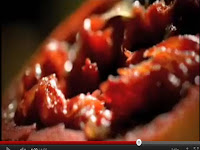Although it cannot be neatly compartmentalised into a specific genre, it has been described as a 'Police Drama' as police investigation is a main theme of the show.
However, the show focuses on the life of protagonist 'Dexter' who is a serial killer that the police in the show do not know the identity of.

Looking at the credits without sound, it is clear to see that the images have clear connotations of 'death' subtly contrasted with a normal life routine, which is what 'Dexter' is all about.
 For example, the credits start with Dexter swatting a mosquito on his arm, which could be a normal every day action, but given the genre of the show, has a more macabre feeling to it. This a constant theme throughout the credits (and is reflected in the show.) Normal actions such as shaving or throwing away the skin of an orange, are shown with a gruesome twist.
For example, the credits start with Dexter swatting a mosquito on his arm, which could be a normal every day action, but given the genre of the show, has a more macabre feeling to it. This a constant theme throughout the credits (and is reflected in the show.) Normal actions such as shaving or throwing away the skin of an orange, are shown with a gruesome twist. No narrative is suggested, however, it is clear that the show will be revolving around one character.
(With soundtrack)
The music used is quite simple and jaunty, and completely contrasts with the gruesome images being presented to an audience. Strings and bells are used and this is significant as the show is set in Miami. The culture of Miami is often shown on the show and the music used collaborates with this.
In a way, the soundtrack DOES contribute to the genre. As said before, the genre is very ambiguous, and so is the protagonist Dexter (he plays a detective, but is really a killer.) In the same way, the cheerful music accompanied by the blood shown in the credits is used to make the audience curious.
The colour scheme has also been chosen to set a certain tone. Dark and bright reds, orange and browns are used. These all have connotations of danger, death and blood. This is also shown when Dexter puts on his t-shirt.
Here, he is wearing white (ironic as white has connotations of life and purity.) However, this has been done for a specific purpose. The white shirt over his face symbolises a white sheet over a body at a morgue, and again, has connotations of death.

 As a member of the audience, we never see his face until the very end. The camera carefully edits the shots to make sure of this. When Dexter looks in the mirror, an Over-the-Shoulder shot is used, and Dexter's reflection is blurred so that we do not see his identity (which again, reflects the theme of the show.)
As a member of the audience, we never see his face until the very end. The camera carefully edits the shots to make sure of this. When Dexter looks in the mirror, an Over-the-Shoulder shot is used, and Dexter's reflection is blurred so that we do not see his identity (which again, reflects the theme of the show.) This then puts the audience in the position of unsurity and is used to make the audience curious.
Camera Angles/Shots/Editing

 - Most of the camera shots used are close-ups. This is used so that Dexter's face is never really shown, but also to make the audience feel uncomfortable, even though all they are seeing is a 'normal' morning routine.
- Most of the camera shots used are close-ups. This is used so that Dexter's face is never really shown, but also to make the audience feel uncomfortable, even though all they are seeing is a 'normal' morning routine. - The camera sometimes 'jump cuts' between different actions. For example, at 0:36 there is just one drop of blood in the sink, but by 0:38 there are suddenly many more. These jump cuts show the passing of time but also speed up the opening titles to keep the audience interested.
- In addition to this 'fade' and blurring an object is also used to show the passing of time. E.g. At 1:20 the focus is taken off the orange the image is blurred.
- At 1:29 the screen flashes bright white and then moves straight to a different scene.
 - The camera focuses on different things. Here, it's the spray coming from the orange and into the air.
- The camera focuses on different things. Here, it's the spray coming from the orange and into the air. - When the morning routine is 'finished' a medium close-up is used to show his identity finally.

Here, a medium long shot is used. This shows him strolling nochalantly, even though the credits have hinted at something not so innocent going on. Again, he's wearing white and this may leave the audience feeling uncertain about whether he is a 'good' or 'bad' character. (This is also a theme that runs through the show, as he is a 'likeable' killer and in the opening titles, has also been portrayed this way.)
The tone of the drama is quite confused; dark contrasted with light. I also think the audience are left to choose what to think rather than being told.



No comments:
Post a Comment